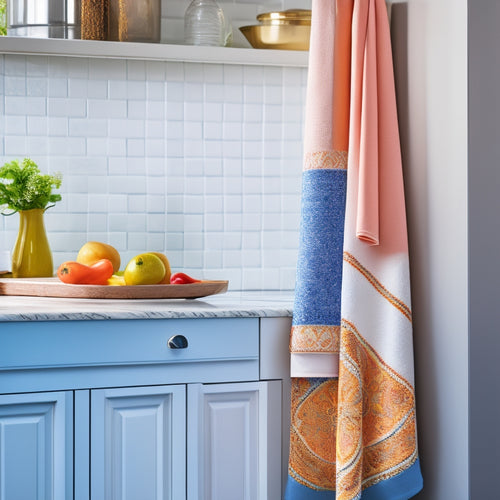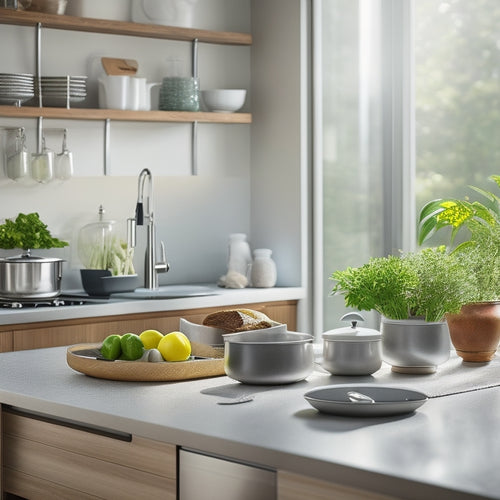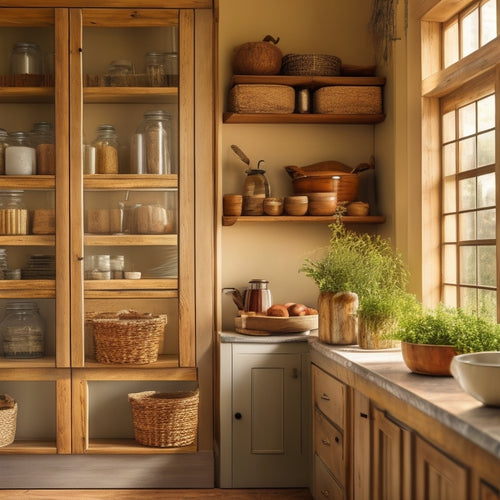
10 Essential Hacks for Efficient Kitchen Cabinet Shelving
Share
To maximize up to 30% more storage space in your kitchen cabinet, start by accurately measuring your cabinet space and accounting for obstructions. Choose adjustable shelving with soft-close mechanisms and ergonomic handles to guarantee easy access. Maximize corner real estate with carousels and curved shelves, and utilize vertical storage with floor-to-ceiling shelves and hanging storage. Don't waste the back of cabinet doors - attach baskets, hooks, or pegboards for extra storage. With these essential hacks, you'll be well on your way to a more efficient kitchen. And, with a few more strategic tweaks, you can create a truly customized space that streamlines your cooking workflow.
Key Takeaways
• Accurately measure cabinet space and account for obstructions to ensure a perfect fit for your shelving units.
• Choose adjustable shelving with soft-close mechanisms and sturdy glides to maximize storage and accessibility.
• Optimize corner cabinet space with corner carousels, curved shelves, and lazy Susans to enhance accessibility and storage.
• Maximize vertical storage by installing floor-to-ceiling shelves, using stackable shelves, and incorporating hanging storage.
• Utilize cabinet doors by attaching baskets, hooks, or pegboards to store frequently used utensils and spices, and enhance kitchen organization.
Measure Twice, Install Once
To avoid costly mistakes and guarantee a seamless installation, take the time to accurately measure your kitchen cabinet space before purchasing shelving units. This vital step will save you from the frustration of ill-fitting shelves and the financial burden of returns or replacements. Make accurate calculations by recording the width, height, and depth of each cabinet compartment. Don't forget to account for any obstructions, such as plumbing or electrical outlets.
Mistake proofing is key in this process. Double-check your measurements to make sure they're correct, and consider enlisting a second pair of eyes to verify your calculations. It's also essential to take note of the shelving unit's specifications, including the dimensions and material thickness. By doing so, you'll be able to determine the perfect fit for your kitchen cabinet space.
Choose Adjustable Shelving Wisely
When choosing adjustable shelving for your kitchen cabinets, you'll want to ponder a few key factors to make sure you get the most out of your space.
You'll need to think about the shelving height options that will work best for your needs, as well as whether customizable shelf spacing is a must-have.
Shelving Height Options
Your kitchen cabinet shelving needs to accommodate items of varying sizes, from compact spice jars to bulky cookware, making adjustable shelving an essential consideration to optimize storage capacity and accessibility.
When it comes to shelving height options, you have two main choices: standard heights and custom heights.
Here are some key considerations to keep in mind:
-
Standard Heights: These are pre-determined heights that are commonly used in kitchen cabinets. They're often more affordable and easier to install, but may not provide the perfect fit for your unique kitchen items.
-
Custom Heights: These are tailored to your specific needs, allowing you to maximize storage and accessibility. While they may be more expensive and require more planning, they can make a significant difference in the functionality of your kitchen.
-
Hybrid Approach: Consider combining standard and custom heights to achieve a balance between cost and functionality. This approach can help you create a more efficient kitchen cabinet shelving system that meets your needs.
Customizable Shelf Spacing
You'll get the most out of your kitchen cabinet shelving by choosing adjustable shelves that allow you to customize the spacing between them, ensuring that every item has its perfect spot. This vital benefit is essential in maximizing your kitchen's storage capacity.
With adjustable shelves, you can easily accommodate items of varying sizes, from large serving dishes to small spices. You can also use shelf dividers to separate similar items or group related products together, making it easier to find what you need when you need it.
Additionally, adjustable shelves enable you to adjust the spacing as your storage needs change over time. For instance, if you acquire new cookware or gadgets, you can simply adjust the shelf spacing to accommodate them.
Sliding Shelf Designs
Opt for sliding shelf designs that feature soft-close mechanisms and sturdy ball-bearing glides to guarantee smooth, quiet operation and effortless access to your kitchen essentials. This thoughtful design element will make a significant difference in your daily kitchen routine. With a soft-close mechanism, you'll appreciate the gentle, quiet closure of your shelves, eliminating the annoying 'bang' of traditional shelves.
When selecting sliding shelf designs, consider the following:
-
Ergonomic handles: Choose handles that fit comfortably in your hand, making it easy to pull out and push in your shelves with minimal effort.
-
Adjustable shelf heights: Ensure the shelves can be adjusted to accommodate items of varying sizes, maximizing your storage space.
-
Durable materials: Opt for shelves made from high-quality, durable materials that can withstand the weight of your kitchen essentials.
Optimize Corner Cabinet Space
When you're designing your kitchen cabinet shelving, don't forget to make the most of the often-wasted space in the corners.
You'll want to maximize this real estate by using clever storage solutions that make it easy to access items you need.
Maximize Corner Real Estate
Two often-wasted areas in kitchen cabinets are the corners, where blind spots and awkward angles can make it difficult to store and retrieve items efficiently. However, with a little creativity and the right solutions, you can turn these dead zones into valuable storage spaces.
To maximize your corner real estate, consider the following:
-
Corner Carousels: These rotating shelves bring items to you, eliminating the need to dig deep into the corner. You can store spices, oils, or frequently used utensils within easy reach.
-
Curved Shelves: These shelves are specifically designed to fit snugly into corner spaces, providing a smooth, continuous surface for storing items like plates, bowls, or cookbooks.
-
Adjustable Corner Baskets: These baskets can be customized to fit your specific needs, allowing you to store items of varying sizes and shapes. They're perfect for storing snacks, cleaning supplies, or other kitchen essentials.
Accessible Storage Solutions
By incorporating accessible storage solutions into your corner cabinets, you can maximize the full potential of these often-underutilized spaces, making it easier to store and retrieve items without straining or struggling. This is particularly important for elderly assistance, as it allows them to maintain independence in the kitchen.
One effective solution is to install a lazy Susan or a carousel in your corner cabinet. This allows you to easily access items at the back of the cabinet without having to dig through everything in front of it.
You can also consider smart systems like pull-out shelves or baskets that bring the items to you, eliminating the need to bend or stretch.
Another option is to use adjustable shelves or baskets that can be customized to fit different sizes of items. This guarantees that everything has a designated place, making it easier to find what you need when you need it.
Maximize Vertical Storage Potential
As you plan your kitchen cabinet shelving, consider installing floor-to-ceiling shelves or storage units that capitalize on the often-wasted space near the ceiling. This vertical expansion allows you to store infrequently used items, such as special occasion dishes or cooking equipment, keeping them out of the way but still accessible. By maximizing your storage ceiling, you'll create a more organized and clutter-free kitchen.
Here are three ways to make the most of your vertical storage potential:
-
Install stackable shelves: These can be adjusted to fit different-sized items and can be easily rearranged as your storage needs change.
-
Use hanging storage: Suspend baskets, bins, or hooks from the ceiling to store items like pots, pans, or utensils, keeping them off the countertops and out of the way.
-
Incorporate pull-down shelves: These allow you to easily access items stored on high shelves, making it simple to retrieve what you need without straining or using a ladder.
Utilize Back of Cabinet Doors
You can turn the back of your cabinet doors into valuable storage space by attaching baskets, hooks, or a pegboard to store items like spices, oils, or frequently used utensils. This is an often-overlooked area that can be optimized with door organizers, which come in various styles and designs.
For instance, you can install a spice rack or a utensil holder on the back of a door, keeping your countertops clear and your kitchen organized.
Consider adding hidden compartments to store less frequently used items, such as special occasion dishes or cookbooks. You can also attach a pegboard to hang items like pots, pans, or kitchen gadgets, freeing up space inside your cabinets.
When choosing a door organizer, think about the items you need to store and the space available. Measure the door and the items you want to store to guarantee a perfect fit.
Select Multi-Tiered Shelving Units
Opt for multi-tiered shelving units that maximize vertical storage and keep frequently used items within easy reach, while reserving lower shelves for heavier or less frequently used items. This will help you make the most of your kitchen cabinet space and reduce clutter.
When selecting a multi-tiered shelving unit, consider the following:
-
Flexible Frames: Look for shelving units with adjustable frames that can be customized to fit your specific cabinet size and storage needs.
-
Space Savers: Choose units with narrow shelves or baskets that can fit snugly into corners or tight spaces, ensuring no area goes to waste.
-
Customizable Height: Opt for shelving units that allow you to adjust the height of each shelf to accommodate items of varying sizes, from large cookbooks to small spices.
Incorporate Lazy Susan Turntables
When you incorporate lazy Susan turntables into your kitchen cabinet shelving, you'll find that they offer a range of benefits.
You'll be able to easily access those hard-to-reach corners, maximizing your storage space and reducing clutter.
Easy Access Corners
Designing easy access corners in your kitchen cabinets involves incorporating Lazy Susan turntables, which rotate to bring items to the front, maximizing the often-wasted space in corner cabinets. This clever hack guarantees that you can easily reach the items you need, without having to dig through the entire cabinet or strain your back.
Here are three essential tips to keep in mind when designing easy access corners:
-
Install Corner Protectors: These safeguard the edges of your cabinets from scratches and dings, while also providing a smooth surface for your Lazy Susan to rotate on.
-
Add Corner Lighting: This helps illuminate the dark corners of your cabinet, making it easier to find what you're looking for.
-
Choose the Right Size: Select a Lazy Susan that fits snugly in the corner of your cabinet, ensuring that it rotates smoothly and doesn't obstruct other items.
Maximize Storage Space
By incorporating Lazy Susan turntables into your kitchen cabinet shelving, you can access hidden storage space and keep frequently used items within easy reach. These clever turntables allow you to make the most of corner spaces and hard-to-reach areas, making it simple to grab what you need without having to dig through clutter.
To maximize storage space, pair your Lazy Susan with storage bins and baskets that fit snugly on the turntable. This will keep items like spices, oils, and condiments organized and easy to access. Don't forget to add shelf liners to prevent items from slipping off and to make cleanup a breeze.
Spin to Find
You'll love how effortlessly you can spin to find what you need with Lazy Susan turntables installed in your kitchen cabinet shelving. This innovative Spin Technology allows you to access items at the back of your cabinet without having to dig through everything in front of it. With a simple spin, you can bring what you need to the forefront, saving you time and energy.
Here are three benefits of incorporating Lazy Susan turntables into your kitchen cabinet shelving:
-
Easy Accessibility: No more digging through cluttered shelves or straining to reach items at the back of your cabinet. With Lazy Susan turntables, everything is just a spin away.
-
Increased Productivity: By reducing the time it takes to find what you need, you can focus on cooking and serving others more efficiently.
-
Reduced Frustration: Say goodbye to the frustration of searching for a specific spice or ingredient. With Lazy Susan turntables, you can quickly spin to find what you need, making cooking a more enjoyable experience.
Designate Zones for Similar Items
Organize your kitchen cabinet shelving into distinct zones, each dedicated to a specific category of items, like baking supplies, cooking utensils, or dinnerware, to create a logical and functional storage system. This way, you'll know exactly where to find what you need when you need it. By designating zones, you'll reduce clutter and make the most of your cabinet space.
Here's an example of how you can categorize your items:
| Item Categories | Task Stations | Zone Assignment |
|---|---|---|
| Baking supplies | Baking station | Top shelf, left cabinet |
| Cooking utensils | Cooking station | Middle shelf, right cabinet |
| Dinnerware | Dining station | Bottom shelf, center cabinet |
| Snacks and spices | Snack station | Top shelf, right cabinet |
Implement a "First In, First Out" System
Now that you've categorized your kitchen cabinet shelving into distinct zones, it's time to establish a system that guarantees the oldest items are used before they expire or go stale.
Implementing a 'First In, First Out' system guarantees that you're using the oldest items first, reducing waste and saving you money. This system is especially important for perishable items with expiration dates.
To make this system work, follow these steps:
-
Track expiration dates: Keep track of when you purchased each item and its expiration date. You can use a label maker or a note-taking app to stay organized.
-
Stock rotation: Place new items behind existing ones to ensure that the oldest items are at the front of the shelf. This way, you'll naturally reach for the oldest items first.
-
Regular inventory checks: Schedule regular inventory checks to remove expired or stale items and restock your shelves.
Label and Sign Everything Clearly
Label and Sign Everything Clearly
Clearly labeling and signing each shelf and storage container helps you quickly identify what's inside, saving you time and reducing frustration when searching for a specific item. By doing so, you'll be able to locate what you need at a glance, making meal prep and cooking more efficient.
Here are some tips to keep in mind when labeling and signing your kitchen cabinet shelves:
| Tip | Description |
|---|---|
| Color Coding | Use different colored labels or stickers to categorize items, such as baking supplies, cooking utensils, or snacks. This visual system will help you quickly identify where items are stored. |
| Font Choices | Choose a clear, easy-to-read font, like Arial or Helvetica, to make sure that labels are easily readable, even from a distance. |
| Specificity | Be specific with your labels, including the contents of each container or shelf. For example, 'Aluminum Foil' instead of just 'Foil'. |
| Consistency | Use a consistent labeling style throughout your kitchen to create a cohesive and organized look. |
Frequently Asked Questions
Can I Use Wall-Mounted Shelves to Increase Cabinet Capacity?
You can definitely utilize wall-mounted shelves to increase cabinet capacity, but don't overlook the load capacity and strategic shelf placement to maximize storage while ensuring stability and accessibility.
Are Soft-Close Drawers Essential for Efficient Kitchen Cabinets?
As you design your dream kitchen, don't sleep on soft-close drawers - they're the unsung heroes of noise reduction, allowing you to sneak in a midnight snack without waking the whole household, and strategic drawer placement can also optimize workflow.
How Often Should I Clean and Maintain My Kitchen Cabinet Shelves?
You should develop daily habits like wiping down shelves after meals and tidying up weekly to maintain your kitchen cabinet shelves. Schedule a seasonal deep clean to remove built-up grime and keep your space organized.
Can I Customize My Cabinet Shelving to Fit Unusual Item Sizes?
"You're a master puzzle solver, fitting unusual items into your cabinet shelves like a pro! Create custom inserts or opt for adjustable compartments to tailor your storage to those odd-shaped kitchen essentials, ensuring a seamless fit every time."
Are Glass Shelves Better Than Wooden or Metal Shelves for Kitchen Cabinets?
You're wondering if glass shelves are better than wooden or metal ones for your kitchen cabinets. Glass shelves offer a sleek aesthetic appeal, but consider durability concerns, as they can be prone to breakage and may not hold heavy items.
Related Posts
-

Over-The-Door Kitchen Towel Holder
An over-the-door kitchen towel holder is a smart way to maximize your space while keeping towels easy to grab. It hoo...
-

Dish Drainer Options for Kitchen Islands
When selecting dish drainers for your kitchen island, consider options that maximize space and enhance workflow. Comp...
-

Freestanding Pantry Units for Farmhouse Kitchen Style
Freestanding pantry units perfectly blend beauty and function in your farmhouse kitchen. They maximize storage while ...


